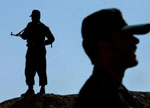 Wall Street Journal: For the last several years, the tendency in analyzing the Middle East from Washington has been to conclude that trends are moving in Iran’s direction, strengthening Tehran’s hand as a regional power and undermining the positions of the U.S. and its allies among the Persian Gulf monarchies. It may be time to rethink that bottom line.
Wall Street Journal: For the last several years, the tendency in analyzing the Middle East from Washington has been to conclude that trends are moving in Iran’s direction, strengthening Tehran’s hand as a regional power and undermining the positions of the U.S. and its allies among the Persian Gulf monarchies. It may be time to rethink that bottom line.
The Wall Street Journal
By Gerald F. Seib
 For the last several years, the tendency in analyzing the Middle East from Washington has been to conclude that trends are moving in Iran’s direction, strengthening Tehran’s hand as a regional power and undermining the positions of the U.S. and its allies among the Persian Gulf monarchies.
For the last several years, the tendency in analyzing the Middle East from Washington has been to conclude that trends are moving in Iran’s direction, strengthening Tehran’s hand as a regional power and undermining the positions of the U.S. and its allies among the Persian Gulf monarchies.
It may be time to rethink that bottom line.
The question is of more than academic importance. As Tuesday’s Capital Journal column notes, Iran’s view of its strengths and weaknesses, now and in the future, is an important question in determining how eager it is to agree to a deal in talks with international powers designed to rein it Tehran’s nuclear programs in return for relief from onerous economic sanctions.
Iran still has plenty going for it, of course, including its leadership of the Shiite Muslim world and its cozy relationship with various regional troublemakers who can antagonize its foes.
But the clouds also are gathering overhead for Iran. The mere fact that those negotiations to put a lid on its nuclear ambitions are chugging along toward a possible deal attests to the level of pain Iran is feeling as a result of international sanctions that Iranian officials openly admit have squeezed their economy more than expected. A failure of the nuclear talks will translate into a prompt American effort to impose even more sanctions.
Other problems lie just beyond Iran’s borders. There, things seemed to be going Iran’s direction for most of the last decade. Leadership of Iraq next door, long a menacing nemesis run by implacable Sunni Muslim foes, had been taken over by a friendly fellow Shiite who once lived in Iran, Prime Minister Nouri al-Maliki. Iran’s principal regional ally, Syrian President Bashar al-Assad, was firmly ensconced in Damascus. Tehran’s friends in the Hamas movement were overtaking more moderate figures as leaders of the Palestinian cause.
On each of those fronts, problems now are breaking out for Iran. Mr. Maliki is besieged. His idea of making Iraq into a Shiite-controlled state is increasingly discredited, and reports say that even Iranian officials now privately tell their foreign counterparts that they aren’t wedded to him.
A civil war has shrunk Mr. Assad’s control of Syria dramatically; large chunks now are beyond his reach. And the cost of helping him to stay in power has gone up.
Meanwhile, on the Palestinian front, Hamas is under attack by Israel, while its lifeline to its onetime ally in Egypt has been squeezed by new Egyptian leader Abdel Fattah el-Sisi, who, diplomats say, sees Hamas as an ally of the Muslim Brotherhood he ousted from power. Its relations with Iran itself are rocky because of Hamas’s unwillingness to support the Assad regime.
Finally, a more powerful and more direct threat to Iran’s regional interests has exploded on the scene. It comes in the form the group that calls itself the Islamic State of Iraq and al-Sham, a violently anti-Shiite armed organization that hopes to both wipe out Iran’s allies in Syria and Iraq and establish a sweeping Sunni caliphate on the ground just beyond Iran’s borders.
The tantalizing question is whether those adverse trends make Iran more amenable to forming at least tacit alliances with those who have been its foes—the U.S., Saudi Arabia, even Israel—but who now see the same dangers as Iran from Sunni radicals. While that would be a logical reaction to current trend lines, Richard Haass, president of the Council on Foreign Relations, isn’t so sure Iran will act that logically. The Iranian regime remains an “anti-status quo” power, he says, one that still sees itself not as a typical stat but “as something larger.”


